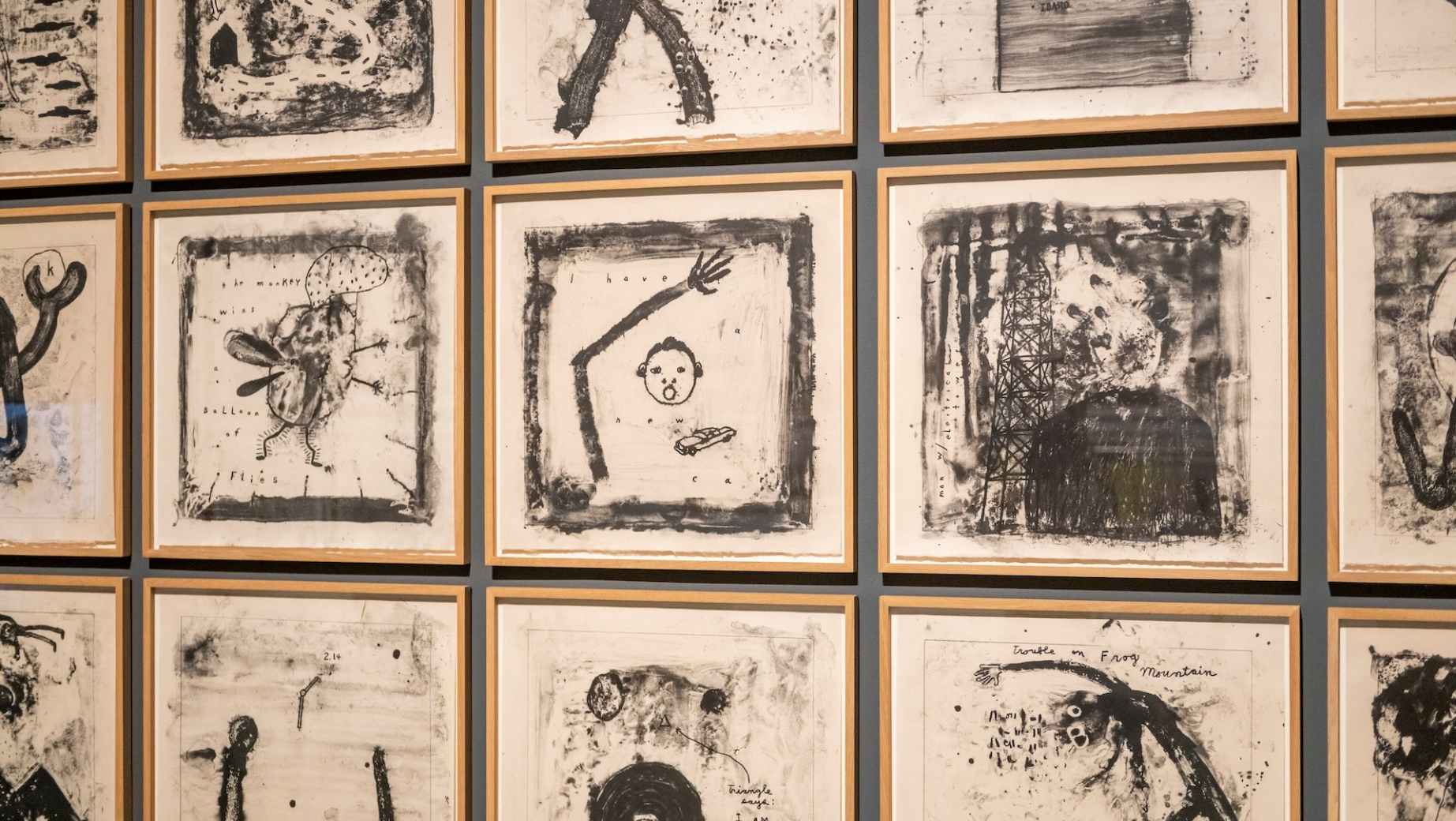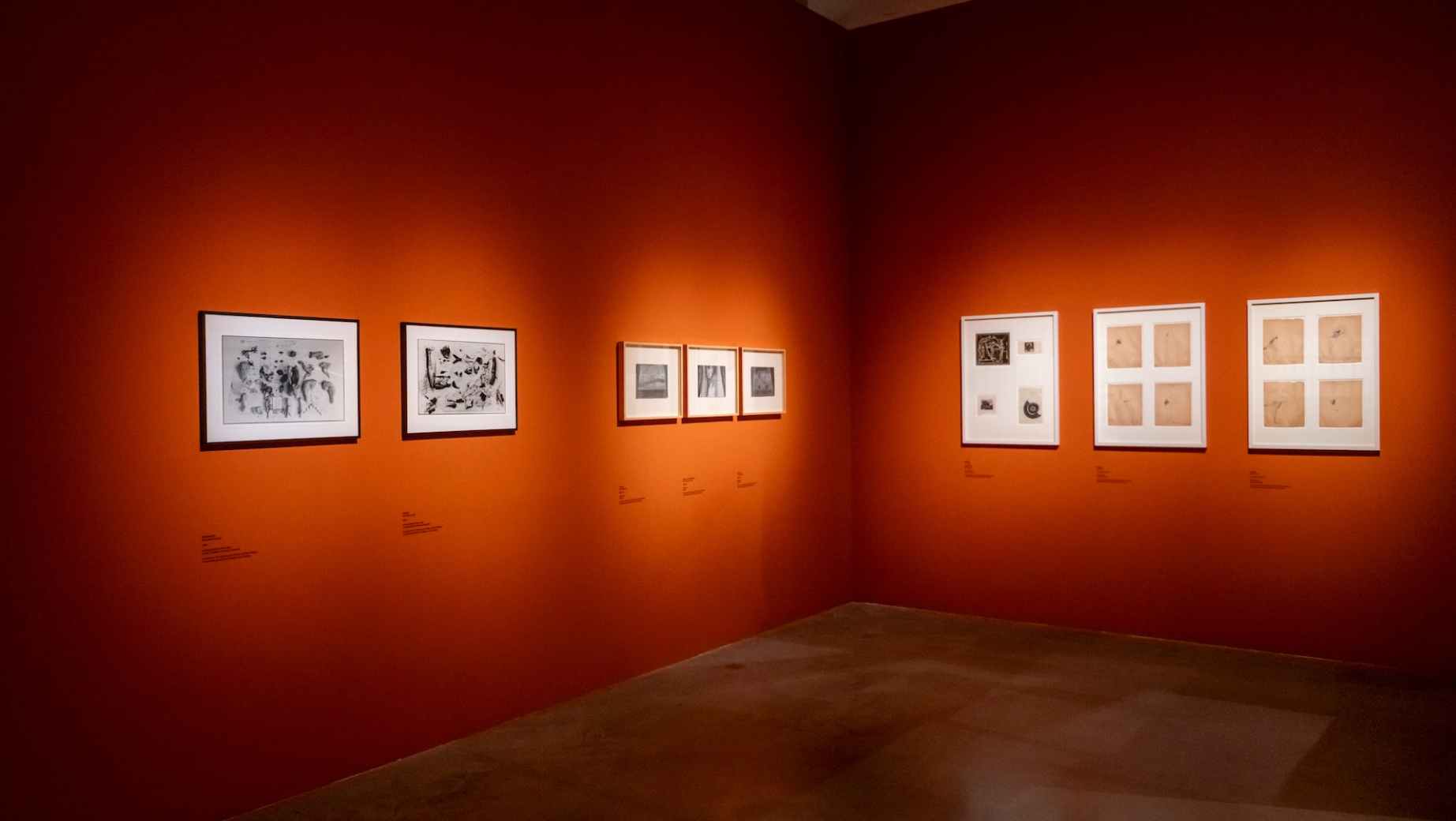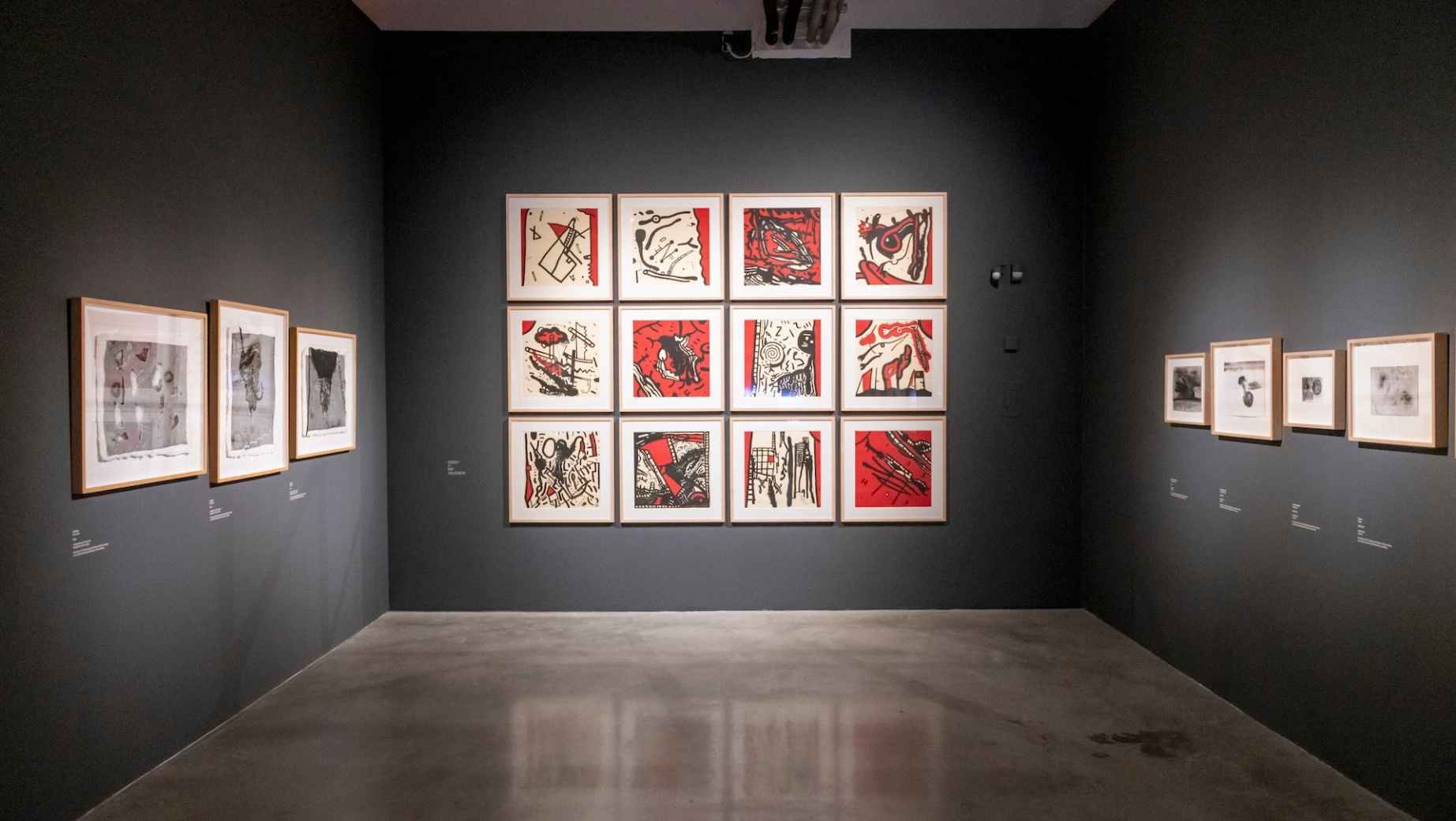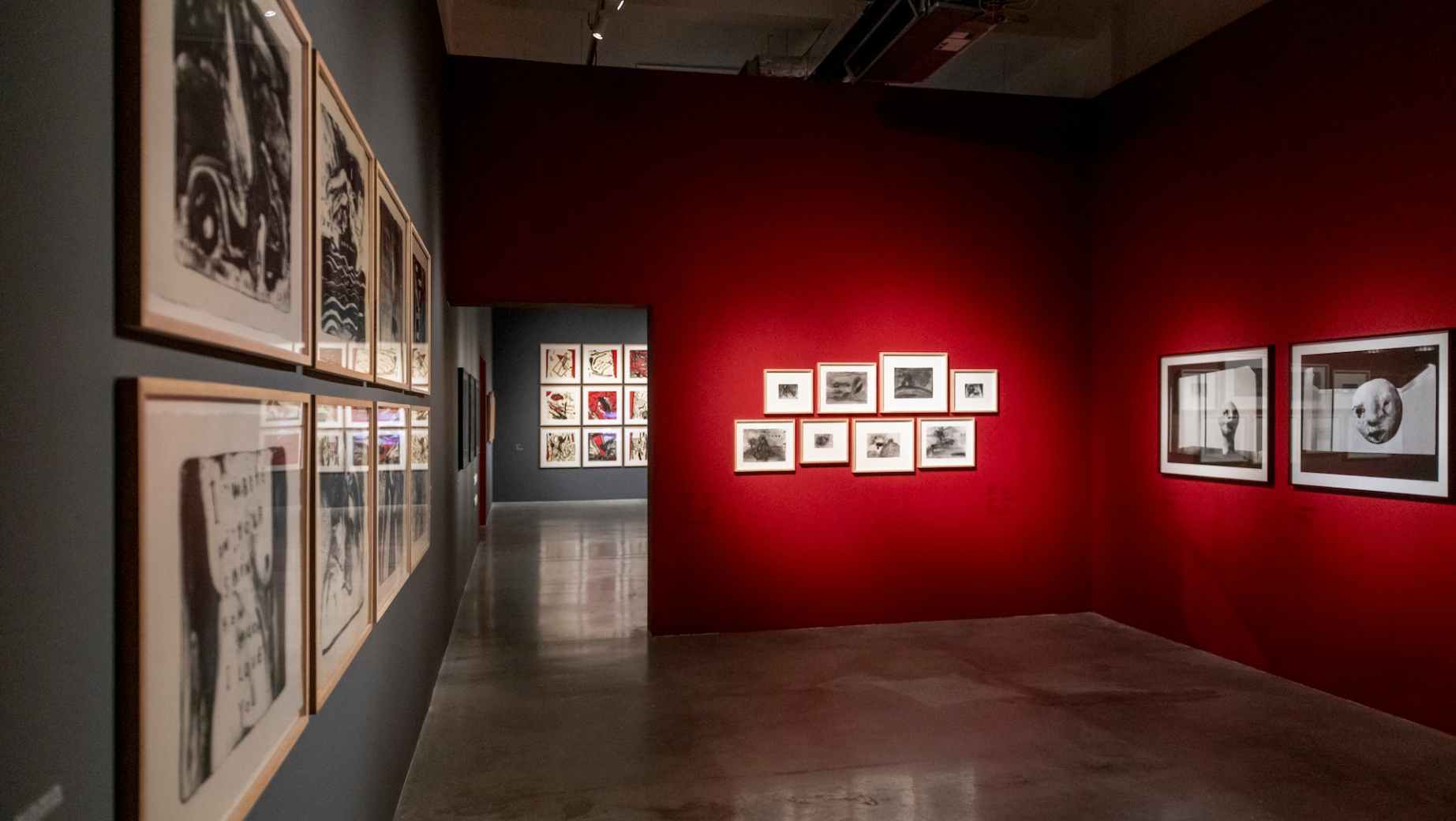The exhibition Up in Flames is the first and largest presentation of David Lynch’s work in the Czech Republic to date.
The exhibition of the American artist David Lynch will present the artistic work of this icon of world cinema for the first time in the Czech Republic.
The exhibition project, which is being prepared in collaboration with the Paris-based studio Item éditions and his representative gallery Pace in Los Angeles, is conceived as a retrospective of Lynch’s artistic output, with an emphasis on his most recent works from the last seven years.
David Lynch’s expressive range of artistic work is very diverse, having worked in drawing, painting, photography, printmaking techniques, design, and animation over the course of nearly six decades.
All these areas will also appear in the exhibition in representative collections, including experimental short films.
The exhibition is not designed chronologically, but will follow specific formal or thematic connections that, among other things, characterise David Lynch’s work.
The project will also include music, film and literary programmes.
Lynch, widely known for directing Eraserhead, Blue Velvet, and Twin Peaks, played an active role in planning the 2024 exhibition. He met with curator Otto M. Urban to approve the final concept and choose the works on display.
“We wanted to present the project to David Lynch in advance as his artistic oeuvre is so extensive that even with a large exhibition space such as DOX it was necessary to narrow down the selection of works,” Urban said through a press release.
“It was important to consider the exhibition as a whole – its structure and the rhythm in which the works enter into dialogue with each other, giving rise to new connections and contexts.”
The Up in Flames exhibition runs from June 19, 2025, to February 8, 2026.
Opening hours
Tue—Sun 11:00—19:00
Would you like us to write about your business? Find out more
Manifesto Market has expanded its culinary line-up just in time for summer, introducing three new food vendors and a refreshed cocktail menu.
The additions bring new flavours from Turkey, India, and Italy, while the resident SOOT Bar debuts a new collection of locally inspired drinks.
One of the new arrivals is Chef Kemal, a street food concept led by Turkish chef Kemal Deniz, who has more than 25 years of experience in his country’s cuisine. Originally from Şanlıurfa, Deniz offers a range of traditional Turkish dishes with a focus on quality ingredients and handmade preparation.
The menu includes well-known staples like lentil soup (mercimek çorbası), börek, meze platters, and grilled kebabs. A highlight is the freshly made pita sandwiches, combining grilled meat or vegetables with herbs and spices in soft flatbread. More dishes are expected to be added in the coming weeks, including options from the Turkish mangal (grill).
Also joining Manifesto is Naan by Lal Qila, a concept developed by Indian chef Shubhankar Chakravorty. Unlike many Indian restaurants in Europe, Naan focuses on authentic street food recipes that are popular in India but less common abroad.
The centrepiece of the menu is the Kathi Roll, a paratha flatbread wrap filled with marinated meat or vegetables, herbs, and sauces. The menu draws from a wide range of Indian regional cuisines, from the Himalayan foothills to the southern coast.
With summer in full swing, Fresca brings handmade Italian-style gelato and fruit popsicles to Manifesto as a seasonal pop-up. Founded with a focus on natural ingredients and originally made for children, Fresca has grown into a retail and wholesale brand that produces small-batch ice cream without artificial additives.
Visualizza questo post su Instagram
SOOT Bar: Local Ingredients, New Cocktails
Meanwhile, SOOT Bar, a fixture at Manifesto, has unveiled a new summer cocktail menu inspired by Czech landscapes and traditions. The team has created house-made syrups, bitters, and infusions from local ingredients such as wild berries, hops, linden blossoms, and plums.
Drinks include the Round & Around, made with Moravian plums, and the Blue Forest, featuring wild blueberries and served in a tin mug. Other highlights include the Garden Martini made with vodka washed in flaxseed oil, and Old Barley, a malt-forward variation on the Old Fashioned using hop bitters.
Would you like us to write about your business? Find out more
Screens at 140 public transport stops across Prague will now display emergency warnings in real time, offering faster communication with residents in the event of floods, violent incidents, or other threats.
The new system is operated by the city’s Crisis Management Team, which can send alerts tailored to specific areas of Prague. This means only residents in affected zones will see the warning messages, helping to avoid unnecessary panic elsewhere.
“There’s no need to alarm people on the opposite side of the city,” said Councilor Michal Hroza (TOP 09), who is responsible for infrastructure. “People will receive alerts only if the situation concerns their location.”
The digital screens—already in use for advertising and cultural event promotion—will now also carry text-based emergency messages. These alerts appear at the top of the screen and, if necessary, will temporarily override ongoing content such as ads or city announcements.
The system is managed by Technologies of the Capital City of Prague (THMP), which maintains the digital infrastructure. The crisis team has direct access to the platform and can trigger alerts instantly, depending on the situation.
“The team can react within seconds,” said Tomáš Novotný, vice-chairman of the THMP board. “They decide what type of alert is needed and whether to interrupt or overlay existing content.”
Commercial messages, including event promotions, won’t be permanently removed—but they can be interrupted in the public interest.
Under the Integrated Rescue System Act, emergency alerts can take precedence to protect public safety.
Would you like us to write about your business? Find out more
The City of Prague has approved the opening of three new contact centers for drug users, reigniting tensions across several city districts.
The move is part of a broader strategy to improve access to harm-reduction services — yet some of the proposed locations are already facing strong local opposition.
One center is set to be built in the metro vestibule below Jungmannovo náměstí, a high-traffic area near the Můstek station.
Another will be placed near Nádraží Holešovice, in repurposed containers located between the metro and railway stations.
The third center will be located somewhere in Prague 9, though the precise site remains under discussion. The project also includes a mobile unit modeled after a successful initiative in Brno.
Currently, only two such centers operate in Prague — Sananim in Prague 5 and Drop In on Karolíny Světlé Street in Prague 1. Experts argue this is far from sufficient for a city of over a million residents.
The proposed expansion aims to distribute these services more evenly and reduce health risks associated with drug use, such as infections and overdoses.
The issue has gained urgency since 2022, when Prague 5 authorities terminated the lease of a contact center operated by the Progressive organization in Smíchov. Since 2009, contact centers in Prague 1, 2, 7, and 11 have also shut down, further reducing service availability.
Why Metro Stations?
The city argues that metro stations offer a strategic advantage: they are easily accessible, already owned by the municipality or the transport authority, and close to areas where users often congregate. The goal, according to the city’s approved materials, is to select sites that are “ideally located in terms of public transport, minimize disruption to the public, and serve users from both central and peripheral areas.”
Former Prague Mayor Pavel Bém (ODS), now chairing the city’s anti-drug commission, is leading the negotiations. His team emphasizes the centers’ role in reducing public drug use, preventing the spread of disease, and connecting addicts with treatment options.
Prague 1 Pushes Back
But not all city districts are on board. Prague 1 officials have submitted a formal objection to the center planned at Jungmannovo náměstí, arguing that their district is already hosting more than its fair share of addiction-related services.
Mayor Terezie Radoměřská (TOP 09) criticized the city’s plan to introduce low-threshold substitution treatment, where addicts can receive methadone or buprenorphine without committing to long-term rehabilitation.
Radoměřská referenced negative experiences with a similar service on Ve Smečkách Street, which was shut down in 2010 following “repeated and well-founded complaints from residents.”
She added that Prague 1 has long advocated for a more balanced distribution of such services across the city, especially in districts that currently lack any form of harm-reduction infrastructure.
Would you like us to write about your business? Find out more
Czechia is in for a rollercoaster week of weather, as heavy rain and thunderstorms continue in some regions, before temperatures climb back to 30°C over the weekend, according to meteorologists from ČHMÚ (Czech Hydrometeorological Institute).
After a tropical weekend that saw highs soar past 31°C, the country starts the new week with a sharp cooldown and widespread showers.
Monday‘s storms—some of them severe—followed a pattern seen across the country over the weekend. According to ČHMÚ, rainfall totals during these events could reach 30 mm, with wind gusts as high as 70 km/h.
By Tuesday, showers will become more scattered, and skies will begin to clear. Expect temperatures to reach 26°C, with light winds below 6 m/s.
Wednesday is expected to be mostly clear to partly cloudy, with isolated rain in the northern highlands. The daily high will push towards 28–29°C, signaling a return to summer conditions.
Thursday will see occasional light rain and cloudy intervals, mainly in the morning, but sunshine is expected later in the day. Temperatures will range from 11°C at night to 26°C during the day, with winds remaining gentle.
Looking ahead to Friday and the weekend, weather models predict mostly sunny mornings, followed by afternoon thunderstorms and intermittent showers, especially in western and central regions.
Nighttime lows will gradually rise from 9–13°C to 12–16°C, while daytime highs are forecast to reach between 27 and 31°C, particularly on Sunday.
By the start of next week, Czechia may once again face a mix of tropical heat and storms, with forecasts pointing to highs above 30°C and increased precipitation, especially in the late afternoons and evenings.
Would you like us to write about your business? Find out more
The Czech government will dispatch a repatriation flight from Israel to Prague on Monday, following escalating tensions between Israel and Iran.
The Foreign Ministry confirmed the mission in a statement on Sunday, citing growing security concerns after a series of Iranian missile strikes overnight left at least ten people dead.
Commercial flights between Prague and Tel Aviv have been suspended since Friday due to the closure of Israeli airspace to civilian aircraft. By Sunday, all remaining direct connections were officially canceled for safety reasons.
“Anyone wishing to board Monday’s repatriation flight must contact our embassy in Tel Aviv in advance,” the ministry stated via its official account on the X platform. The government also issued a strong warning against travel to Israel, Lebanon, and Jordan, advising Czech citizens to refrain from visiting the region altogether.
Despite the current airspace shutdown, Czech authorities noted that overland departures from Israel are still possible. Travelers can exit via Jordan, through the Eilat–Aqaba and Allenby Bridge border crossings, or through Egypt via the Eilat–Taba checkpoint.
The ministry emphasized that passengers should stay in close contact with their airlines and monitor flight updates closely.
Additionally, the Foreign Ministry urged all Czech nationals abroad to register in the DROZD system, which helps the government track and assist its citizens in foreign countries during emergencies.
The recent spike in violence began with a dramatic increase in missile attacks from Tehran, as tensions between Iran and Israel continue to spiral. In response, Israel has mobilized its defense systems, and several countries have begun repatriating their citizens.
Would you like us to write about your business? Find out more
Seeing a ticket inspector step onto a tram or metro can instantly make any passenger nervous — especially if you’re riding without a valid ticket.
While those with a valid pass may breathe a sigh of relief, others start thinking fast: What now?
If you’re caught riding Prague’s public transport without a valid ticket, don’t panic. The fine is usually 1,500 CZK, but there’s a way to lower it to 800 CZK — legally.
The first rule: keep calm and respectful. Arguing or acting aggressively won’t help — inspectors have heard it all, and it only makes things worse. If the inspector catches you without a valid ticket, they’ll issue a fine, but you’re not required to pay immediately.
Here’s how to reduce that fine.
The Prague Public Transit Company (DPP) offers a way for fare-dodgers to correct their mistake at a lower cost — if they act quickly.
Step 1: When you’re caught, allow the inspector to issue the fine — don’t pay on the spot. You’ll receive a written record of the violation.
Step 2: Buy an annual public transport coupon for 3,650 CZK. This must be tied to your PID Lítačka account or card, and your name must match what’s on the fine.
Step 3: Within five business days, take both the newly purchased annual coupon and the inspection record to the DPP surcharge office at Na Bojišti 5 (Prague 2), or settle the fine online via the DPP e-shop.
By proving that you’ve now paid for an annual pass, the fine is reduced to 800 CZK — a kind of “amnesty” offer for becoming a proper paying customer.
What If You Have a Ticket But Can’t Prove It?
Sometimes, people do pay — but can’t show it at the right moment. Here’s what to do in those cases:
You left your valid pass at home:
If your Lítačka or paper ticket is valid but you weren’t carrying it during the check, bring it later to the DPP office and pay a 50 CZK administrative fee. They can verify your pass and cancel the fine.
Your pass expired recently:
If your coupon is no longer valid, it’s treated the same as not having a ticket. But again, if you buy a new annual pass quickly, you may still qualify for the reduced 800 CZK fine.
You forgot to activate your mobile ticket:
Having a purchased pass in your app is not enough — it must be activated. If it’s not, it’s considered invalid. You’ll get a fine, but again, you may still qualify for the discount if you buy an annual coupon.
Would you like us to write about your business? Find out more
As summer temperatures rise in Prague, public transport can quickly turn from a convenience into a challenge—especially for those sensitive to heat.
But there’s good news: Prague’s public transport company has shared a simple way to identify air-conditioned vehicles, helping commuters stay cool while navigating the city.
The most reliable way to ride in comfort is to board the Škoda 15T4 tram model. These newer trams come with fully functional climate control systems in the passenger cabin. They’re easy to spot thanks to the yellow plastic panels at the front—currently, 127 of these modern trams operate across Prague.
Older Škoda 15T models, on the other hand, typically have air conditioning only in the driver’s cabin. These trams feature a grey and red nose with no yellow inserts. However, there are two exceptions—trams numbered 9243 and 9285—which do have passenger cabin climate control installed as part of a test program.
How to Check in Advance: Use the Live Map
To avoid waiting in the heat, passengers can check the official online map of Prague’s public transport system, which shows the real-time positions of all trams and buses.
By entering the route number into the search field, users can view all vehicles currently running on that line. Clicking on a specific tram or bus icon reveals detailed information—including a snowflake icon, which confirms whether air conditioning is available.
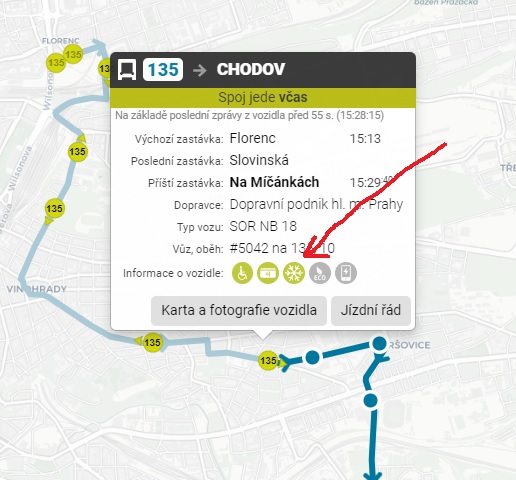
It’s important to understand how the climate control system operates. The system switches on automatically once the outside temperature rises above 22°C. Drivers cannot adjust the settings manually, as the regulation is fully automated.
Here’s how it works:
- At outside temperatures between 22°C and 25°C, the interior cabin temperature is maintained between 20°C and 25°C.
- When temperatures climb above 25°C, the air conditioning cools the cabin to 1–6°C below the outside temperature.
Would you like us to write about your business? Find out more
The Prague Garden Party will return to the Royal Gardens from 20 to 22 June 2025, offering visitors a mix of European food, live music, and family-friendly activities.
Now in its second year, the event combines access to the historic Royal Gardens with food stalls from more than 30 exhibitors, cultural performances, and a full children’s programme.
The central part of the event focuses on gastronomy, with a wide range of stalls presenting regional specialities.
Offerings include grilled meats, cheeses, crêpes, charcuterie, seafood, and desserts. Among this year’s featured vendors are Fransyr (European cheeses), Bread Society (French pastries), Greek Delikatessy (Mediterranean cuisine), and Milleme (quiches and desserts).
A selection of European wines, ciders, beers, and crémants will also be available from both Czech and international producers.
Live Performances and Music
The festival includes a three-day live music programme, with genres ranging from flamenco and jazz to classical and swing. Performers include Flamenkeria, Jazzpot, Pragason, Kryštof Bartošek, Cancioneta Praga, and the Sophia Lamos Swing Band.
Most concerts will take place on the Míčovna stage and in the courtyard of Queen Anne’s Summer Palace.
Visualizza questo post su Instagram
Activities for Families and Children
Daily programming for children will run throughout the festival. Children under 15 can enter for free, and primary school pupils will receive sweet treats in recognition of the end of the school year.
Venue and Tickets
The event is set in the Royal Gardens of Prague Castle, including the Belvedere terrace and views of the city. Visitors are welcome to bring blankets and enjoy the grounds picnic-style.
Opening hours are from 10:00 to 20:00 each day. Day tickets are priced at 150 CZK, while a three-day pass is available in advance for 200 CZK on goout.net until 15 June. After that, full-price passes cost 350 CZK.
The gardens are accessible via tram lines 22 and 23, or through the Prague Castle complex.
Would you like us to write about your business? Find out more
In Czechia, eating out during the workday has become a growing luxury.
According to the latest Edenred Restaurant Index, the cost of lunch has risen steeply across the country – and nowhere more so than in Prague.
The average lunch menu in the capital now costs 220 CZK, making it the most expensive in the country. Just behind is Brno, where employees pay 208 CZK for a midday meal.
Meanwhile, cities like Zlín, Ústí nad Labem, and Olomouc remain on the more affordable end, with prices up to 55 crowns lower.
The national average for a lunch menu now stands at 196 CZK, highlighting a steady climb in prices that has outpaced wage growth. Since 2014, lunch prices have jumped by more than 130%, while average salaries rose by roughly 82% over the same period.
Back in 2020, workers in Prague paid just 149 CZK on average for lunch. In cities like Ostrava or Jihlava, it was even cheaper—hovering just over 120 CZK. But the most dramatic comparison goes further back. In 2014, Prague diners paid only 98 CZK, while in the Pardubice Region, lunch cost a mere 75 CZK. In a decade, the price of lunch has more than doubled across Czechia.
“It wasn’t that long ago that a lunch menu under 100 CZK was standard across the country. Now, that price is almost unimaginable in most places,” says Aneta Martišková from Edenred. She adds that the price hike has had a visible effect: the number of people eating out for lunch has dropped by 21% in recent months.
Despite the fall in customers, prices are expected to continue rising. Economic pressures, ingredient costs, and energy prices are pushing restaurants to adjust their lunch menus accordingly, Martišková warns.
The gap between the capital and other regions also seems unlikely to close soon. While Prague’s business districts sustain higher prices, cities like Zlín remain more affordable, partly due to lower operational costs and different consumer habits.
Would you like us to write about your business? Find out more
Amid rising military tension in the Middle East, Prague’s Václav Havel Airport has suspended all flights to and from Israel.
The cancellations were confirmed early Friday morning via the airport’s official account on the X social media platform.
Airport authorities cited security concerns due to escalating conflict between Israel and Iran, urging travelers to monitor the airport’s website for updates and to stay in touch with their airlines for the latest information.
“There is a gradual cancellation of all flights with Israel due to the deteriorating political situation,” said the airport, located in Prague’s Ruzyně district. Direct connections between Prague and Tel Aviv—Israel’s second-largest city—have been suspended until further notice.
Due to the current political situation, flights to and from Israel are being gradually suspended. Passengers are kindly advised to check the latest status of their flight on the airport’s website and contact their airline for further information. pic.twitter.com/UlJ8gsj1qw
— Prague Airport (@PragueAirport) June 13, 2025
According to the airport’s schedule, four outbound flights to Tel Aviv were originally planned for Friday. One has already been canceled, and all five incoming flights from Tel Aviv to Prague have also been called off.
The decision follows a major Israeli aerial offensive launched overnight, during which over 200 aircraft dropped more than 330 munitions on roughly 100 targets across Iran, according to the Israeli Defense Forces.
In response, Iran deployed over 100 drones aimed at Israeli territory—some of which are expected to reach their targets within hours.
Israeli Prime Minister Benjamin Netanyahu stated that the operation was intended to strike nuclear scientists allegedly working on a bomb, the Natanz nuclear facility, and Iran’s ballistic missile infrastructure.
Analysts suggest the scale of the Israeli assault could mark the largest military strike against Iran since the Iran-Iraq War in the 1980s.
Would you like us to write about your business? Find out more
Michael Douglas will present a newly restored print of Miloš Forman’s “One Flew Over the Cuckoo’s Nest” at Karlovy Vary Film Festival next month.
The 1975 classic, which celebrates its 50th anniversary this year, will screen as part of the festival’s Out of the Past section. The film was restored by the Academy Film Archive.
Douglas will be joined at the Gala Screening by Paul Zaentz — nephew of the late Saul Zaentz, who produced the film with Douglas — as well as members of Forman’s family.
The film made Oscar history as only the second to win all five major Academy Award categories: picture (Douglas and Zaentz), director (Forman), actor (Jack Nicholson), actress (Louise Fletcher), and adapted screenplay (Lawrence Hauben and Bo Goldman).
The screening also honors Karlovy Vary’s ties to the film. Forman was a loyal supporter of the festival, and he, along with Douglas, Zaentz and actor Danny DeVito, who also appeared in the film, are all recipients of the festival’s Crystal Globe for outstanding artistic contribution to world cinema.
“We are truly honored to present ‘One Flew Over the Cuckoo’s Nest’ on its 50th anniversary,” said the festival’s executive director Kryštof Mucha. “The presence of Michael Douglas, Paul Zaentz and the Forman family will make this an unforgettable moment in the festival’s history.”
Adapted from Ken Kesey’s novel, “One Flew Over the Cuckoo’s Nest” follows Randle McMurphy, a rebellious gambler whose defiance of authority challenges the rigid confines of a mental institution. A powerful parable of freedom versus control, the film marked a turning point in Forman’s career and paved the way for his later international successes.
Douglas last visited Karlovy Vary in 1998, when he and Saul Zaentz were honored with the Crystal Globe.
Paul Zaentz worked closely with Forman on “Amadeus” (1984) and “Goya’s Ghosts” (2006), and produced acclaimed titles including “The English Patient” (1996) and “The Talented Mr. Ripley” (1999).

